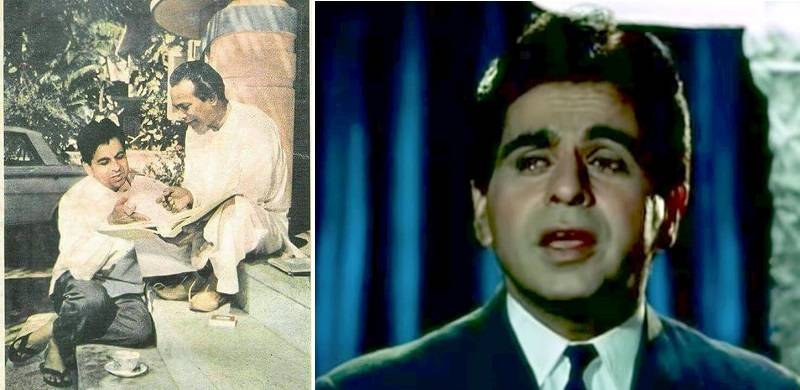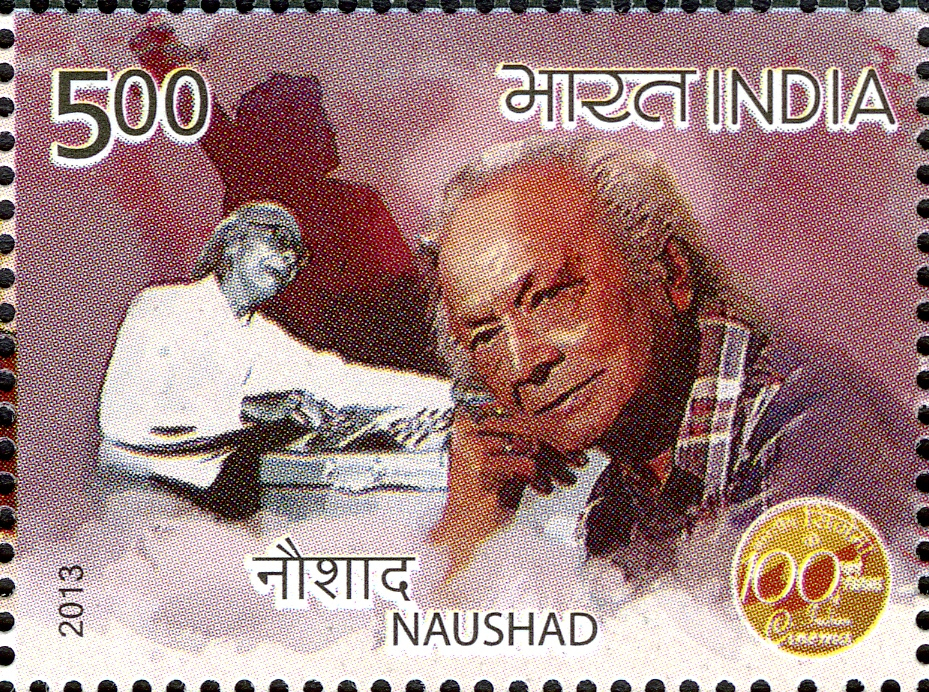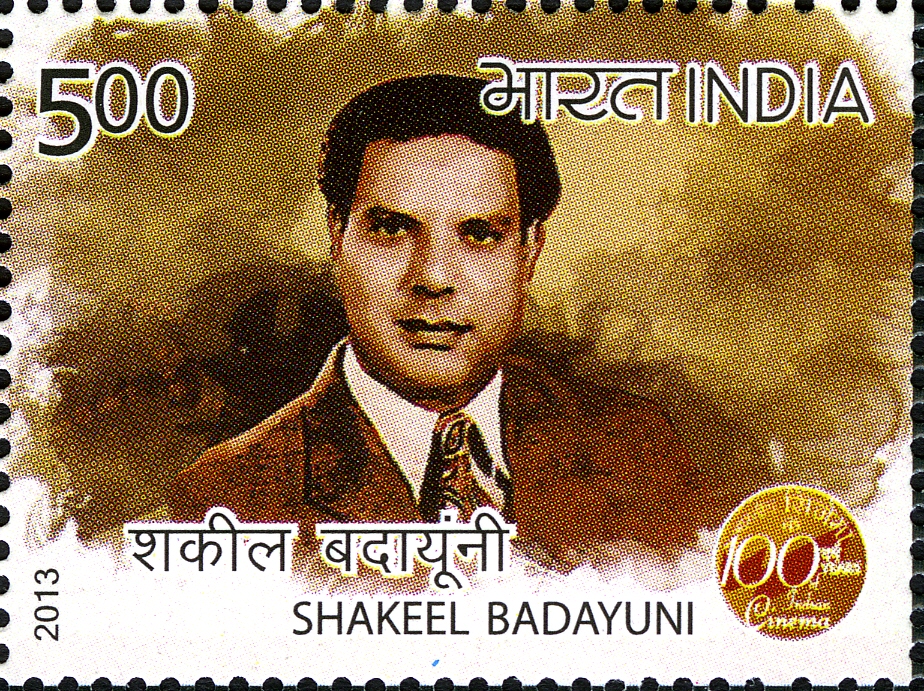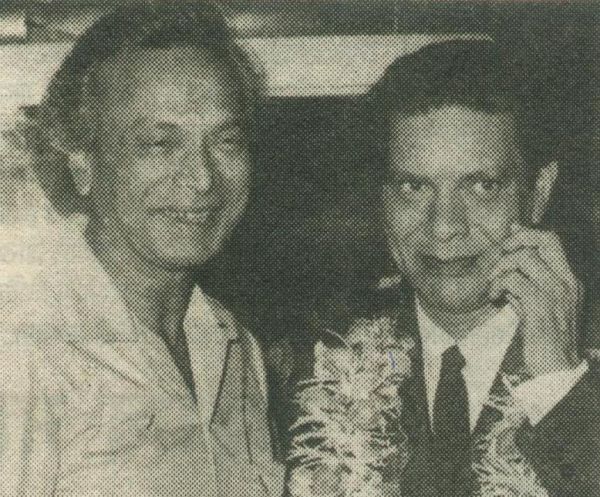
Indian cinema is richer today due to the amazing contribution of songs, music and lyrical poetry which graced the screen. Many of the big-hitters in the male leads in the 1950s, 60s and even the 70s had their own preferences for their music directors. Mind you, it was not only for their own home productions, but they would use their leverage to influence the producers wherever they could, as they were well aware that their songs played as much of a role in their success, as their acting. Raj Kapoor had Shankar-Jaikishan (at least until Jaikishan’s death in 1971), Dev Anand worked with SD Burman until the latter’s death in 1975 and superstar Rajesh Khanna did a record 15 commercially successful films with RD Burman between 1969 and 1971.
This article attempts to explore the work of the thespian Dilip Kumar with Naushad and Shakeel.
It was not just his acting brilliance as the “Tragedy King” a title that was given to him, which so many have written about, especially after his passing away. Dilip Kumar’s poetical and musical inclinations have had a more far-reaching impact on Indian cinema than what most people speak about, let alone write. Out of 40 odd released films in which he played the male lead from 1944 to 1974, 14 of them had the music score by Naushad with lyrics penned by Shakeel Badayuni. Such was the bond formed by them over the years.
Dilip Kumar earned 19 nominations for best actor at the Filmfare Awards in his career, winning eight, three of them back to back (which is a record), but the roles played by their songs in his success is a story in itself. Mohammed Rafi (MR), Mukesh (MM) and Talat Mahmood (TM) provided the playback for Dilip Kumar and Lata Mangeshkar (LM), Shamshad Begum (SB), Asha Bhosle (AB) featured in most songs for the female playback singing for his leading ladies. There were just a few isolated ones performed by others. Allow me to take you on a walk-through of their musical journey and the scenery, spread roughly across 20 years.
1.) MELA (1948)
It all started with Mela, a romantic tragedy produced and directed by S U Sunny, which turned out to be a catalyst for the careers of everyone connected with the film. Nargis was pitched as the leading lady opposite Dilip for the first time. The music of the film played a major role in the commercial success at the box office with a Silver Jubilee status. Many of the songs are remembered even today, after 75 years.
Ye Zindagi Ke Mele (MR), Gaye Ja Geet Milan Ke (MM), Phir aah dil se nikli (Zohrabai A), Dharti Ko Aakash Pukare (SB/ MM), Mera Dil Todne Wale (SB/MM), Aayi Sawan Ritu Aay (SB/ MM) Main Bhanwra Tu Hai Phool (MM/SB), Mohan Ki Muralya Baje (SB), Taqdeer Bani Ban Kar Bigdi (SB), Pardes Balam Tum Jaoge(SB).
Rafi had just one song, but it was good enough to launch his career. The music hall of Famous Studios, which was later named Shankar-Jaikishan Hall, was inaugurated with the recording of the songs of Mela.
2.) BABUL (1950)
Riding on the huge success of Mela, the team rolled out Babul. Produced and written by composer Naushad himself and directed by S.U. Sunny, this film too was a huge box office success, becoming the second highest earning film of 1950. Nargis was again in the female lead. The film was packed with 10 amazing compositions, each bringing its own unique feel to it. Duniya Badal Gayi (SB/TM), Chhod Babul Ka Ghar (SB /chorus), Kisi Ke Dil Mein Rehna Tha (SB/LM), Lagan More Man Ki (LM), Mera Jeevan Sathi Bichhad Gaya (TM), Milte Hi Ankhen Dil Hua (SB/TM) Pancchi Ban Mein Jia Mora (LM), Husn Walon Ko Na Dil Do (TM), Jadoo Bhare Nainon Mein (SB), Nadi Kinare Sath Hamare (SB/TM/MR).
3.) DEEDAR (1951)
Deedar followed next year. It starred Nargis and Nimmi with Dilip and was directed by Nitin Bose. It was a story of unfulfilled love, where the hero's childhood love is separated from him due to class inequalities. It is one of noted tragedies made in early Hindi cinema, became a popular film of the Golden era and firmly established Dilip Kumar as the "King of Tragedy". By now, 10 songs in their films had become a standard!
Huwe Hum Jinke Liye Barbad (MR), Naseeb Dar Pe Tera Aazmane Aya Hoon (MR), Meri Kahani Bhoolnewale (MR), Dekh Liya Meine Kismat Ka (MR/LM), Le Ja Meri Duayen Le Ja (LM), Duniya Ne Teri Duniyawale (LM) Bachpan Ke Din Bhula Na dena (LM/SB), Chaman Mein Rehke Veerana (SB). Shakeel’s lyrics were to die for.
4.) AAN (1952)
Released as The Savage Princess in the United Kingdom and United States, Aan was a 1952 Indian Bollywood adventure film, produced and directed by Mehboob Khan. It was India's first technicolor film, shot in 16mm Gevacolour and was blown up in Technicolor. It stars Dilip Kumar, Premnath, and Nimmi, and marked the highly charged debut of the Jewish actress Nadira.
Aan was both, the most expensive Indian film ever and also the highest-grossing Indian film ever until that time, domestically and overseas. Aan was the first Indian film to have a worldwide release in many countries, subtitled in 17 languages and released in 28 countries, including the UK, USA, France and Japan. The film also received critical acclaim in the British press.
Naushad’s 10 song portfolio continued. The following songs still remain etched on the souls of many filmgoers. Maan Mera Ehsan aray nadaan (MR), Dil Mein Chhupake Pyar Ka Toofan (MR), Jane ke baad teri yaad ayee (LM), Aaj Mere Man Mein Sakhi Bansuri (LM), Mohabbat Choome Jinke Hath (MR/SB), Gao Tarane Man ke (MR/LM/SB), Takra Gaya Tumse (MR).
5.) AMAR (1954)
Not all Dilip Kumar films were guaranteed hits – not even with Naushad and Shakeel Badayuni by his side. Ace director Mehboob Khan’s Amar bombed badly at the box office. A string of glorious hit songs had already made their mark much before the film was released, but the controversial subject of rape was too overwhelming for the audience at that time. Nevertheless, Nimmi scored a hatrick with Amar, although Madhubala was in the female lead role. The immortal songs were Insaaf Ka Mandir Hai Ye Bhagwan Ka Ghar Hai (MR), Na Milta Gham To Barbadi Ke Afsane (LM), Naa Shikwa Hai Koyi Naa Koyi Gila Hai (LM), Jane Wale Se Mulaqat Na Hone Payee (LM) Udi Udi Chhai Ghataa Jiya Leharaye (LM/chorus).
6.) URAN KHATOLA (1955)
Uran Khatola was a romantic-drama film produced by Naushad and directed by S.U. Sunny. Madhubala was initially offered to play the female lead, but she declined due to her volatile health condition. Nimmi was taken in her place. The soundtrack presented 11 melodious songs, all of them turned out to be hits to varying degrees, even the sad songs. Many Naushad/Shakeel followers consider these songs as their best.
O door ke musafir ham ko bhi sath le le re (MR), Na Ro Ae Dil kabhi rone se (LM), Haal-e-Dil Main Kya Kahoon (LM), Na Toofan Se Khelo (MR), Ghar Aaya Mehman Koi (LM), Mera Salam Le Ja, dil ka payam leja (LM/chorus), Hamare Dil Se Na Jana dhoka na khana (LM), Ho Moray Saiyan Ji Utrenge Paar(LM), Dooba Tara Ummeedon ka doob gaya (LM) Sitaron Ki Mehfil saji tumna aye (LM).
7.) KOHINOOR (1960)
Kohinoor was a costume drama film. Once again, S. U. Sunny was the director. It is said that Dilip had gone into depression after playing tragic roles in many films and his psychiatrist recommended to him to do some lighter acting roles. One such opportunity which came his way was in Kohinoor. The cast had Dilip Kumar and Meena Kumari to play a prince and princess of different kingdoms and was full of sword fights, songs and dances. This film is also notable for some rare comical and funny scenes by Meena Kumari, who was otherwise known as the Tragedy Queen and our man Dilip Kumar, the Tragedy King. However, it was the latter, who walked away with the Filmfare Award for Best Acting.
Naushad’s well acclaimed soundtrack for Kohinoor became a cult favorite among music lovers because of its soul stirring compositions. The best known song in the soundtrack is Madhuban Mein Radhika Nache Re, a classical dance song, composed on Rāga Hamir sung by Mohammed Rafi. From a total of 10 songs, the following gems, featuring vocals by Mohammed Rafi, Lata Mangeshkar and Asha Bhosle were well received. Madhuban Mein Radhika Nache Re (MR) Dil Mein Baji Pyar Ki Shehnaiyan (LM), Jadugar Qatil (AB), Zara Mann Ki Kewadiya Khol (MR), Chalenge Teer Jab Dil Par (MR/LM), Yeh Kya Zindagi Hai (LM), Do Sitaron Ka Zameen Par Hai Milan (LM/MR) Koi Pyar Ki Dekhe Jadugari (MR/LM)
8.) MUGHAL E AZAM (1960)
Mughal e Azam is to Madhubala, what Pakeezah is to Meena Kumari and Mother India to Nargis. Released in August 1960, it broke all box office records in India and became the highest-grossing Indian film of all time, a distinction it held for 15 years. The film cost more to produce than any previous Indian motion picture. As of 2021, the film still remains the highest-grossing film in India when adjusted for inflation. In fact, the budget for a single song sequence exceeded the typical cost for an entire film of that period. Mughal-e-Azam was the first black-and-white Indian film to be digitally coloured, and the first in any language to be given a theatrical re-release. The color version, released in November 2004, was also a commercial success.
As with most Naushad soundtracks, the songs of Mughal-e-Azam were heavily inspired by Indian classical music, particularly ragas such as Darbari, Durga, used in the composition of "Pyar Kiya To Darna Kya" and Kedar, used in "Bekas Pe Karam". He also made extensive use of symphony orchestras and choruses to add grandeur to the music. The 12 songs rendered by Lata Mangeshkar along with Mohammed Rafi, Shamshad Begum and classical singer Bade Ghulam Ali Khan are often cited among the finest in Bollywood cinematic history. These songs account for nearly one-third of the film's total run time.
Mohe Panghat Pe (LM), Pyar Kiya To Darna Kya (LM), Mohabbat Ki Jhooti Kahani (LM), Humein Kash Tumse (LM), Bekas Pe Karam Keejeye (LM), Teri Mehfil Mein (LM/SB), Khuda Nigehban ho tumhara (LM), Ae Mohabbat Zindabad (MR) Prem Jogan Ban Ke and Shubh Din Aayo (both by Bade Ghulam Ali Khan).
One of Bollywood’s mysteries over 60 years is that how Mughal-e-Azam, expected to steam-roll the Filmfare Awards out of its 7 nominations, went home with just three Awards including the Best Film, but missed out on Best Director (K. Asif), Best Lyrics (Shakeel Badayuni) and Best Playback Singer (Lata for "Pyar Kiya To Darna Kiya") Naushad's loss for Best Music for Mughal-e-Azam's epic soundtrack to Shankar-Jaikishan for Dil Apna Aur Preet Parai, still makes people scratch their heads.
9.) GANGA JUMNA (1961)
Directed by Nitin Bose and produced by Dilip Kumar himself, the film was a trendsetter in Indian cinema. Dilip's performance as Ganga is considered one of the finest acts in the history of Indian cinema, inspiring future generations of Indian actors, notably Amitabh Bachchan. The film's plot also inspired screenwriter duo Salim–Javed, who wrote several cripts exploring similar themes in later Bachchan-starrers such as Deewaar (1975), Amar Akbar Anthony (1977) and Trishul (1978). Vijayanthimala was in the female lead.
The soundtrack consisted of 8 songs, featuring vocals by Mohammed Rafi, Lata Mangeshkar, Asha Bhosle and Hemant Kumar.
Dhundo Dhundo Re Sajna (LM) Daghabaaz Tori Batiyan (LM), Do Hanson Ka Joda (LM), Jhanan Ghunghar Baje (LM), Nain Lad Jayi hain (MR), O Chhalia Re, Chhalia (MR/AB), Tora Man Bada Papi (AB), Insaf Ki Dagar Pe (Hemant Kumar).

10.) LEADER (1964)
Leader was a colored and cinemascope film Dilip Kumar bagged the Filmfare Award for Best Actor, with Vyjayanthimala in the female lead. The film is a case study of where a film could fail despite Dilip Kumar, Naushad, Shakeel Badayuni and all the bells and whistles in it. The script was too weak to carry the water.
Sahir Ludhianvi came very close to being selected to pen the lyrics, but in the end, the proven and trusted partnership of Naushad and Shakeel prevailed. Here are the songs created by them:
Aaj Hai Pyar Ka Faisla (LM), Tere Husn Ki Kya Tareef (LM/MR), Ek Shahenshah Ne Banwake (LM/MR), Apni Azadi Ko Hum (MR), Hameen Se Mohabbat (MR), Mujhe Duniya walo sharabi (MR), Aaj Kal Shauq-e-Deedar Hai (MR/AB) and Daiyya Re Daiyya Laaj mohe aye (AB), which was the first song to be recorded.
11.) DIL DIYA DARD LIYA (1966)
This was a Hindi romance film based upon Emily Brontë's 1847 novel Wuthering Heights. A color film, it was directed jointly by A R Kardar and Dilip Kumar himself, with Waheeda Rehman as the leading lady.
The film ran into a lot production issues, specially from financiers. There were also internal conflicts within the team. In addition, many of the scenes had to be re-shot multiple times. So much so, that the ending was totally changed from the original sad to a happy one. Not surprisingly, in the end, the film did not click. The songs were a redeeming factor.
Dil Diya Dard Liya (MR) Guzre Hain Aaj Ishq Mein (MR,) Koi Sagar Dil Ko (MR) Sawan Aaye Ya Na Aaye (MR/AB). Two mujra songs - Rasiya Tu Bada Bedardi and Dil Haarnewale(both AB) Phir Teri Kahani Yaad Aayi (LM) Kya Rang-e-Mehfil Hai (LM).
12.) RAAM AUR SHYAM (1967)
The trio of Dilip, Naushad and Shakeel were still in top form, but while the music was there, the old magic seemed to be missing. Dilip played a double role of twins separated at birth, in this comedy, with Waheeda Rehman and Mumtaz joining the team, making it the second highest-grossing Indian film of the year.
A Naushad film with just six songs was a rarity. Aaj Ki Raat Mere Dil Ki Salami le le (MR), Aayi Hai Baharein Miten Zulm-o-Sitam (MR), Main Hoon Saqi, Tu Hai Sharabi Sharabi (MR/LM), Balam Tere Pyar Ki Thandi Aag Mein (MR/AB ) Aaj Sakhi Ri Mora Piya Ghar Aye"(AB) Dheere Dheere Bol Koi Sun Lega (MK/AB).
13.) SUNGHURSH (1968)
After Leader, Vyjayanthimala teamed up with Dilip once again, which turned out to be their working together for the last time. They had worked in several films which performed well commercially. However, unlike their previous collaborations Sangharsh was a box-office flop. Waheeda Rehman had replaced Vyjayanthimala in Ram Aur Shyam, which was being shot simultaneously with Sunghursh.
The film's soundtrack has seven songs by Mohammad Rafi and Lata Mangeshkar, with one by Asha Bhosle. All are solo songs where Naushad used the music from the regions of Awadh and eastern Uttar Pradesh. However, critics rated these compositions "below par", compared with other Naushad/Shakeel work.
Chhedo Na Dil Ki Baat (LM), Ishq Diwana (MR), Tasveer-E-Mohabbat (AB), Mere Paas Aao Nazar To Milao (LM), Mere Pairon Mein Ghunghroo (MR), Agar Yeh Husn Mera (LM) Jab Dil Se Dil (MR).
14.) AADMI (1968)
Aadmi shines because its life-like characters portrayed by Dilip Kumar, Waheeda Rehman, Manoj Kumar, Simi Grewal and Pran not only share the screen honors, but also provide the film with several moments of compelling brilliance. Besides being noted for Dilip Kumar's acting as a man in a wheelchair, the film is also known for its dialogues by Akhtar ul Iman and brilliant trick work cinematography by Faredoon Irani. The film was a moderate success at the box office.
There were two immortal melodies - Rafi's soulful cry Aaj Purani Rahon Se and the male duet Kaisi Haseen Aaj Baharon ki Raat by Rafi and Talat (replaced by Mahendra Kapoor on Manoj Kumar's insistence and an act for which Talat never forgave Naushad till his death). Other songs were Na Aadmi Ka Koi Bharosa (MR), Main Tooti Hui ek Naiya Hoon (MR), Kal Ke Sapne Aaj Bhi Aana (LM), Kari Badariya Mare Leheriya (LM).
At the 16th Filmfare Awards, Dilip Kumar was nominated for the Best Actor for Sunghursh as well as for Aadmi. However, Shammi Kapoor had created a major Bollywood upset by his performance in Brahmachari, his only Best Actor award and with it, providing a huge feather in his cap.
As they say, all good things must come to an end, so did the musical alliance of Dilip Kumar, Naushad and Shakeel Badayuni. The premature death of Shakeel in April 1970 (at age 53) brought this famous film partnership to a grinding halt. Although Naushad continued to compose a few more years to keep his kitchen lights on and Dilip Kumar switched to character roles to extend his career, these films without the heart-touching lyrical poetry of Shakeel Badayuni seem incomplete. No words could possibly describe the vacuum created by this alliance, after hitting the right notes consistently from 1948 through to 1968.
By this time, the musical they had produced together had transformed into their unique collective legacy.
Rafi has capsuled these sentiments vividly in his rendition of “Aaj purani rahon se koi muje awaaz na de”

